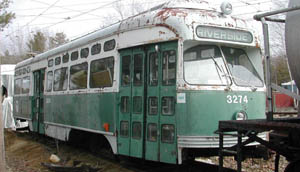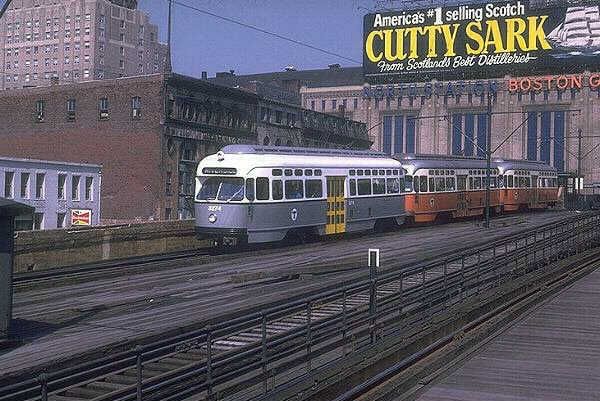
Matthew D. Cosgro in 2002
- Builder
- Pullman-Standard Car Co.
- Description
- PCC, Post-war air-electric
- Secondary Use
- None
- Type
- City and Suburban Streetcars
- Year
- 1951
- Retired from Service
- 1978
- Acquired by the Museum
- 1978
- Fund
- 581
Massachusetts Bay Transportation Authority 3274
From Boston, Massachusetts
History
The PCC car takes its name from the Electric Railway Presidents Conference Committee established in the early 1930s to design a modern, streamlined streetcar. It was a successful design with approximately 5000 PCC cars being built between 1936 and 1952 for systems in the U.S. and Canada. Some PCC cars built after World War II used the all-electric variation having electric brakes instead of the earlier air-operated brakes.
Although an early participant in the PCC development program, Boston took a long time to place a large order. This was due to the use of left hand loading at subway stations and other locations. In 1937, the Boston Elevated purchased one PCC from St. Louis Car, but it lacked a left hand door which limited its use. To modify the PCC design for left hand loading, the ERPCC required a full sized mockup of any changes to the basic design. Since adding the left hand door required moving the right center door and the motor generator set, the cash strapped Boston Elevated took time to complete the work. Boston placed its first large order for 20 PCCs in 1940 with delivery in 1941. In 1944 and 1945, Boston Elevated acquired wartime austerity model PCCs. In 1946, Pullman built 25 post-war style, all-electric PCCs for the Boston Elevated. In 1951 Pullman built 50 PCCs (Nos. 3272 – 3321) for Boston’s MTA which was the successor to the Boston Elevated. This was the last new series of PCC cars for Boston. These post-war style PCCs featured double size picture windows, a style unique to Boston. For the 1951 purchase, the MTA reverted back to the air-electric variation for compatibility with the bulk of Boston’s PCC fleet. The picture-window cars were used on Beacon St. and on the Riverside line after that line opened in 1959.
The PCC cars continued under Massachusetts Bay Transportation Authority ownership beginning in 1964. After 1951, the MTA had a large fleet of 321 PCCs, and the MTA added 25 additional second-hand PCCs in 1958. Pullman-Standard built all of Boston’s PCCs except for the first car in 1937. When the MBTA adopted its color-coding scheme for its various transit lines in 1967, the MBTA repainted most of its PCC cars from their original orange and white to a green and white paint scheme. In 1976, the MBTA began replacing the PCC cars with LRV cars such as No. 3424 which is now at Seashore. Even after the LRVs became museum pieces, eleven PCC cars continue to run in regular service on the MBTA’s Ashmont – Mattapan line.
After its retirement, No. 3274 came to Seashore in 1978. No. 3274 has vacuum electronics which prohibits its operation at Seashore. In 1991, Seashore acquired a similar Boston picture-window PCC, No. 3292 with the objective running the two cars coupled together in MU operation. Seashore has not done significant work on either picture-window car. Seashore has acquired representatives of each type of Boston PCC: Pre-war style (No. 3019), wartime with a flat roof (No. 3127), wartime with raised roof (No. 3083), Post-war with standee windows (No. 3221), Post-war with picture windows (Nos. 3274 and 3292), and double-ended (No. 3340).
Technical Information
- Seats: 42
- Control: General Electric MCM
- Brakes: Dynamic / Air Drum / Track
- Compressor: DH-10
Trucks
- Number: 2
- Manufacturer: Clark
- Model: B-2
Motor
- Number: 4
- Manufacturer: General Electric
- Model: 1243A1
Weight and Dimensions
- Length: 46’ 6.00"
- Width: 8’ 8.00"
- Height: 11’ 1.00"
- Weight: 40280 lbs.
Additional Images

In Boston on Aug. 6, 1970 by Joe Testagrose at newdavesrailpix.com
© 1998 - 2026 New England Electric Railway Historical Society. All Rights Reserved.